
Five UC San Diego Bioengineers Named 2012 Siebel Scholars
By:
- Daniel Kane
Published Date
By:
- Daniel Kane
Share This:
Article Content
Five bioengineering Ph.D. students from the University of California, San Diego whose research is aimed at improving human health are among the 2012 recipients of the annual Siebel Scholars awards. Selected for their outstanding academic performance and leadership, each student receives a $35,000 fellowship during the final year of their studies.
“We are proud to support the Siebel Scholars Class of 2012 as they collaborate and forge lifelong ties with this engaged community of leaders,” said Karen Roter Davis, executive director of the Siebel Scholars Foundation. “They are joining an exceptional group of talented individuals working together with the Siebel Foundation to address critical societal issues in health, food and energy.”
The five new Siebel Scholars from the UC San Diego Jacobs School of Engineering are part of the Department of Bioengineering, which ranks 1st in the nation for biomedical engineering, according to the 2010 National Research Council (NRC) rankings.
With the 2012 class of Siebel Scholars, 85 new scholars join an ever-growing, lifelong community of leaders. Today, 700 Siebel Scholars are active in a program that fosters leadership, academic achievement and the collaborative search for solutions to the world’s most pressing problems.
UC San Diego Siebel Scholars: Class of 2012
Jessica DeQuach
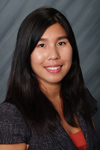
Bioengineering grad student Jessica DeQuach. Photo Credit: UC San Diego Jacobs School of Engineering.
Jessica DeQuach develops tissue specific matrices for injectable tissue engineering scaffolds to treat ischemia in the brain, skeletal muscle, and heart and cell culture coatings for stem cell and progenitor differentiation. This research has led to four patent applications in addition to a start-up company founded by bioengineering professor Karen Christman. DeQuach is a member of Christman’s Biomaterials & Regenerative Medicine Lab.
After she completes her Ph.D., DeQuach plans to help commercialize her research for a year before pursuing a postdoctoral fellowship in the field of drug delivery. Ultimately, DeQuach hopes to become a professor in bioengineering to develop new ways to heal patients, collaborate with engineers and physicians, and mentor the next generation of scientists.
Outside of research, she co-chaired both the annual Graduate Research Symposium and Bioengineering Day, a networking event between students, faculty, alumni and industry that celebrates research in the department.
DeQuach also helped lead a team of bioengineering students that participated in the Inaugural USA Science & Engineering Festival in Washington, D.C. The team explained to children how heart valves work in the circulatory system.
DeQuach is also a recipient of the 2011 Mary Ann Liebert, Inc. Outstanding Student Award from the Tissue Engineering and Regenerative Medicine Society (TERMIS) which is awarded to one graduate student in the nation per year.
Che-Ming Jack Hu
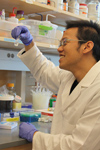
Grad student Che-Ming Jack Hu in the Zhang Research Lab. Photo Credit: UC San Diego Jacobs School of Engineering.
Che-Ming Jack Hu focuses primarily on the development of nanotechology platforms and anticancer nanomedicine. Hu is fascinated by the complexities of biological systems and their implications to nanoscale engineering. These interests have inspired Hu to seek creative ways to incorporate biological entities with synthetic nanomaterials. His innovations and research efforts are most notably found in his work on disguising nanoparticles as red blood cells to evade the body’s immune system and deliver cancer-fighting drugs, which was published last June in the Proceedings of the National Academy of Sciences (read the press release from the Jacobs School).
In the Nanomaterials & Nanomedicine Laboratory led by Liangfang Zhang, a professor in the Department of NanoEngineering at the Jacobs School of Engineering and UC San Diego Moores Cancer Center, Hu has contributed authorship to 10 peer-reviewed publications. What motivates Hu most is the possibility of translating his research to practical solutions. He is excited that his work on nanoparticle-based combination therapy has been granted a U.S. patent and was recently licensed. By applying novel nanotechnology approaches to the continuing development of drug delivery, Hu hopes to take part in the collective effort on the fight against cancer.
“The recognition from the Siebel Foundation makes me believe more strongly in myself and in what I do,” says Hu, who aspires to become a professor in the field of bioengineering.
Dan Kagan
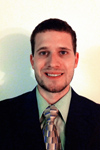
Grad student Dan Kagan. Photo Credit: UC San Diego Jacobs School of Engineering.
Dan Kagan crafts nano-scale rockets that can detect cancer cells, isolate proteins and provide targeted drug delivery. Kagan is a Ph.D. student in professor Joseph Wang’s Laboratory for Nanobioelectronics in the Department of NanoEngineering at the Jacobs School of Engineering.
Kagan couldn’t sleep the night before he was officially notified about the award. “I am ecstatic,” he said. “I have been working very hard in the lab, and I am honored to be recognized with such a prestigious award.”
Kagan plans to use some of the funds to explore possible ideas for a startup company after he graduates in spring 2012. His research focuses on nano-scale motors that can be propelled in a variety of ways. To develop some of the nanorockets in Wang’s lab, he exploited a relationship between a solution’s silver ion concentration and the speed of gold and platinum nanowires for sensing nucleic acids. He also found a way to make binding to biological targets, such as DNA and RNA, more effective by using microrockets propelled by oxygen bubbles. The motors and rockets are fairly cheap to manufacture – and their motion is visible with a strong magnifying glass. (For related work, Kagan won best NanoEngineering poster at Research Expo 2011.)
Kagan also plans to use some of the award to help develop a guide to molecular biology protocols and troubleshooting in the lab. Proceeds from the guide’s sales would go to science materials for high school classrooms.
When he isn’t in the lab, Kagan is the cultural coordinator for UC San Diego’s Graduate Student Association. He plans field trips to museums, the symphony and Broadway San Diego shows, among other destinations. He also organized the first-ever graduate student art competition on campus in March. Kagan is also training for the New York City Marathon on Nov. 6, 2011.
Lauren Hruby Jepson
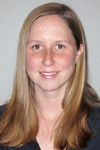
Grad student Lauren Hruby Jepson. Photo Credit: UC San Diego Jacobs School of Engineering.
Lauren Jepson, a Ph.D. student who divides her time between the Salk Institute and the Department of Bioengineering at the UC San Diego Jacobs School of Engineering, is working on building a better retinal prosthesis for the visually impaired.
The Siebel Scholars award will allow her to connect with top-notch researchers and entrepreneurs. “I am excited to meet my fellow Siebel Scholars and explore potential research collaborations, both within and outside of my research area, at next month’s Siebel Scholars Conference at Janelia Farm in Virginia,” she said.
The bulk of Jepson’s work takes place at the Salk Institute in the lab of neurobiology Professor E.J. Chichilnisky. Gabriel Silva, a professor in the Jacobs School’s bioengineering department and co-director of UC San Diego’s Retinal Engineering Center, is her co-advisor.
Retinal prostheses work by injecting pulses of current into the retina through electrodes placed on the retina’s surface. These pulses allow researchers to manipulate retinal activity and transfer visual information to the brain in patients suffering from retinal diseases that can lead to blindness. Jepson’s goal is to understand how these current pulses influence activity in the retina. She works in a controlled setting in the lab with a retinal preparation that allows her to inject patterns of current that carry precise spatio-temporal information through an array of electrodes that are about 10 microns in diameter. She records the retina’s activity resulting from these patterns of current.
Nathan Lewis
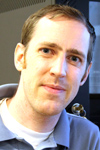
Grad student Nathan Lewis. Photo Credit: UC San Diego Jacobs School of Engineering.
Nathan Lewis’ research involves the use of large models of metabolism to study prokaryotic biochemistry and evolution; neurological disorders involving metabolism; and how gene content of Chinese hamster cell line genomes may affect the glycosylation modifications on proteins, thereby possibly affecting quality and safety of biopharmaceutical products. Eventually, Lewis plans to lead an academic lab and aims to develop translational applications of his work to human health.
Lewis is also part of a collaboration that aims to improve science education through the development of an international outreach program. This will facilitate economic growth in developing countries and improve science literacy among the public. Lewis is a member of the Systems Biology Research Group run by UC San Diego bioengineering professor Bernhard Palsson.
In November 2010, Lewis co-authored a paper in Nature Biotechnology that provided an explanation for why some types of neurons die sooner than others in the brains of people with Alzheimer’s disease. (Read the Jacobs School press release: Metabolism Models May Explain Why Alzheimer’s Disease Kills Some Neuron Types First)
Siebel Scholars Program
The Siebel Scholars program was established by the Siebel Foundation in 2000 to recognize the most talented students at the world’s leading graduate schools of business, computer science and bioengineering. In 2009, the Siebel Foundation recognized the Jacobs School of Engineering’s pioneering efforts in bioengineering with a $2 million endowment, the first year the program included top students who were breaking new ground in bioengineering. Thomas Siebel, founder of the software company Siebel Systems Inc., is a leading philanthropist who has devoted substantial time and money to strategic philanthropy.
Share This:
You May Also Like
Stay in the Know
Keep up with all the latest from UC San Diego. Subscribe to the newsletter today.


